This journal is brought to you by:
- Magda Fleming and her 2nd grade students at Jackson Elementary
- Students at St. Philomena Junior High in Peoria, Illinois
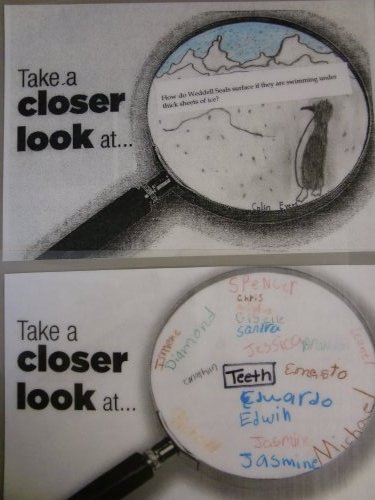
A Closer Look at … a Weddell Seal’s Teeth & Jaw
Open wide! Let’s take a look inside the mouth of a Weddell Seal!
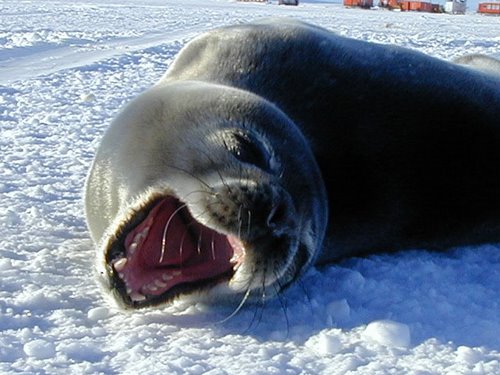
No doubt, the first thing that ‘sticks out’ to you in this picture are the teeth! Let’s bite into Weddell seal teeth and divide them into two sections: front teeth and back teeth!
Front teeth - Canines and Incisors
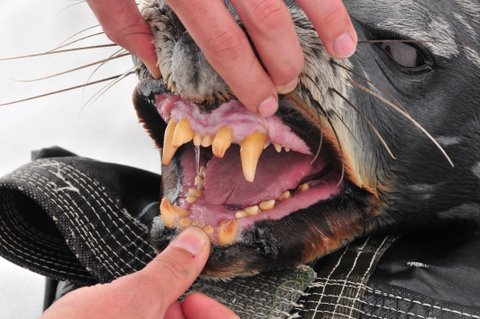
You can surely tell these seals are carnivores (meat eaters) by looking at their teeth. Check out those canines! Weddell seals have 4 canine teeth – located on the sides of the front teeth, two on top and two on the bottom. Carnivores have long canines that are used for quickly grabbing prey.
Between the canines are 4 incisors – 4 on top, 4 on bottom. Notice how much larger the outer two incisors are compared to the 2 in the middle (on both top and bottom). Most carnivores use their incisors to help hold prey, but ‘Wedds’ have another special use for them. Take a look at this next picture and see if you can figure it out!
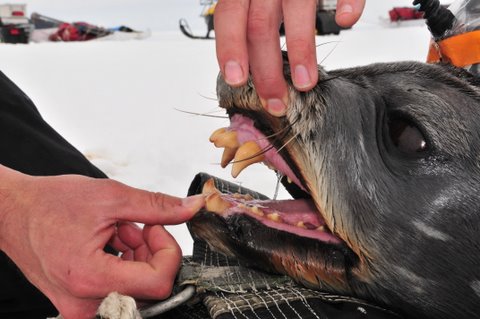
Notice anything that sticks out a bit?
Sure - their canines! But do you know why?
You may remember that Weddell seals live further south than any other seal, and the ones we are studying here live under the Ross Sea iceThere are terms for different types of ice. Shorefast ice forms along coasts and is attached to land. Pack ice is ice floating in open water. Multiyear ice is ice that has survived at least 1 summer. First year ice is ice that has not yet survived a melting season. shelf. But how do they get above the ice to breathe? – With the help of their teeth! Weddells are able to survive under the ice shelf because their canines and incisors are specially adapted (they stick out) which allows them to ream, or break through the ice to make and keep their breathing holes open.
Check out this video to see how they do that! Weddell seal shaving ice with teeth to maintain breathing hole Video Credit: BBC Natural History Unit, Arkive
Did you notice how far the seal opened its mouth to ream the ice? Just like our jaw, the top part is stationary while the lower part, or mandible, moves up and down. The Weddell seal can open its jaw very wide - which makes it easy when reaming an ice hole or opening wide to swallow a foot-long fish.
With all that reaming, it’s no wonder that their teeth show some wear and tear as they get older!
Did you know? Unlike humans, Weddell seals get one set of teeth. A pup’s teeth grow in when they are nursing - during the first 6 weeks of their lives.
Back Teeth - Post-canines
In the back of a seal’s mouth - where our premolars and molars would be - are the post-canine teeth. If you have a mirror – take a look at your molars and compare them to this picture of the Weddell’s post-canine teeth.
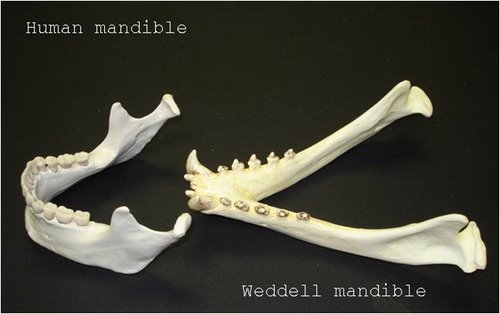
Our molars have a broad rectangular shape, are basically flat on top with a slight dip in the center.
The post-canine teeth of a Weddell have a small oval base which peaks to a rounded point. Very different, but why? Can you guess?
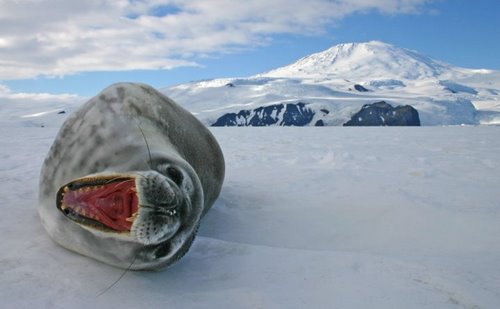
Our molars are used to grind food after we’ve taken a bite. Since Weddell seals typically swallow their food whole, they don’t use post-canines for grinding food – their teeth are used to help get the food down.
Go Deeper!
Just like your dentist knows how many and what kind of teeth are in your mouth, scientists know all about seal mouths too! They use a dental formula, which tells them which teeth to expect to see in the mouths of particular animals. The dental formula divides the upper and lower jaws in half and starts in the middle, so “I 2/2” means there are 2 incisors on the right side and 2 on the left side of each jaw; and since incisors are listed first, they are closest to the middle of the mouth. Check out the dental formulas for Weddell seals and humans:
Weddell seals: I 2/2, C 1/1, PC 5/5 (I = incisor, C = canine, and PC= post canine)
Humans: I 2/2, C 1/1, P 2/2, M 3/3 (P = premolar and M = molar)
Did you notice that the number and distribution of teeth are basically the same? – The difference is in the shapes!
In reference to photos provided by Jennifer Burns, Daniel Costa and myself: The activity/animal depicted was conducted pursuant to NMFS Permit No 87-1851.


Comments